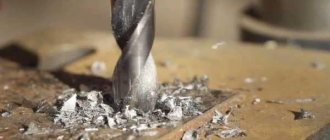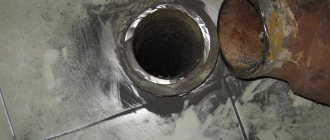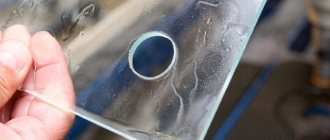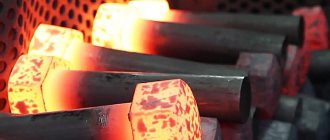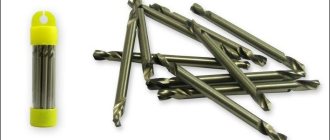When doing repairs, many owners have to perform a wide variety of work, among which drilling is quite common. However, to perform this task well, you must have a suitable drill available. There are no problems with purchasing this device, given that there are a large number of different types on the building materials market.
Therefore, every home craftsman who has purchased a drill should also worry about choosing good drills. Otherwise, they will quickly use up their service life, and you will have to spend money on new ones.
In stores you can find a large number of different drills, differing in length, diameter, and material for which they are intended. And even before you start creating a hole on the surface of the structure, you should decide on the appropriate drill size . To avoid mistakes here, it is necessary to take into account the type of work being performed.
Methods for drilling holes in hardened metal
How to drill a hole in hardened metal using acid, a welding machine, special drills and what additional tools are needed for this. Which drills work best with hardened steel?
It is not difficult to drill ordinary steel or any other metal; standard drills made of high-speed material are used for this. Drilling through hardened steel is another matter: it requires some work. After hardening, the workpiece acquires extraordinary strength, and the question arises of how to drill a hole in hardened metal, because in this case an ordinary drill can no longer help much.
Experts recommend making holes in the parts before hardening occurs. You can also try tempering the steel, then drill and harden the material again. If this is economically justifiable and technically feasible, then this should be done, but in some cases it is simply impossible to do otherwise than proceed to obtain a channel on an already hardened surface.
There are several methods that allow you to drill holes of any diameter in hardened metal. These methods can be implemented with great success both in production and in the home workshop.
Drilling with a cobalt drill for metal
Even before you start drilling, you should decide the issue with the cutting mode. To clarify, let us inform you that the main parameters that affect such a mode are the following:
- Cutting speed . It is usually understood as the conditional peripheral speed of a drill for metal, which is demonstrated by the drill in relation to the element being processed. In other words, this parameter means the degree of rotation speed of the drill through metal. For example, it is possible to ensure the same cutting speed of 20 m/min, provided that a drill with a diameter of 1.0 is used for the work, and its rotation speed is 6366 times per minute, or you can use a device whose diameter is 10.0, and the frequency rotation is 637 rpm.
- Submission . We are talking about the degree of movement of the working device in the direction of the drilling axis over a period equal to one revolution. Accordingly, the unit of measurement is millimeter per revolution.
- Torque . This parameter determines the level of load that falls on the metal drill during cutting.
Each of the above parameters influence each other, and when choosing them it is necessary to take into account:
- The material in which the hole needs to be created;
- The material from which the metal drill is made is cobalt;
- Equipment used for work and type of cooling;
- Other factors, which include the degree of surface roughness, contamination, etc.
Methods for drilling hardened steel
Drilling hardened steel is characterized by high heating of the surface of the workpiece and tool, which leads to rapid wear of the latter. Therefore, during processing, they try to remove excess heat or make the area where the channel will be softer.
The first method, which allows you to make hot metal more pliable, is based on the use of acids. Suitable substances may include nitric, perchloric or sulfuric acid. These liquids are used pointwise, that is, they are used to treat specifically the place where there will be a hole in the future (the area is etched). To prevent the acid from leaving the working area from materials not exposed to acid (polymers, paints, paraffin), something like a side is organized around the future hole. The hole is filled with active liquid and left for a certain time. Next, drill with a regular drill.
The easiest way, but not the cheapest, is to purchase a special drill designed for making holes in hardened metal. The cutting edges of such a tool are reinforced with pobedit tips or made of pobedit plates. In this case, it is also desirable to use additional cooling of the work area.
When working with acids, you need to be extremely careful and perform the operation in a well-ventilated area. This will help prevent burns or poisoning from harmful fumes.
Category: “We work with metal”
Of course, you need to drill steel until it’s hot.
And if you come across a hardened workpiece (especially a thick one), release it, drill holes with a regular drill and harden it again, if necessary. But this option is not always possible and justified; sometimes non-standard situations arise in which it is necessary to drill (perforate) steel that is already very hardened. Well, for example, the blade of a knife broke, or you decided to make a knife from a piece of a saw. It’s a pity to throw away such valuable material; skilled people usually give such things a second life.
Yes, it’s not technologically advanced, but folk craftsmen have come up with many different ways to drill hardened steel, or how to make holes in it. To do this with less effort, you need to proceed from the capabilities and materials that you have, and also depending on what purposes. Maybe, instead of a hole, you will be satisfied with just a slot with a grinder, into which you can put a screw and secure the part. To make the slot smaller, you need to make it on both sides, and use a trimming disc of the smallest diameter, i.e. almost erased.
Before drilling, you need to thoroughly examine the steel to see how hard (crumb) it is, and from there choose methods. If, after all, the steel bends even a little and then breaks (this can be determined by the broken end or by running it with a file), then it can be drilled with an ordinary concrete drill with pobedit tips. True, the drill must be sharp. It is also very advisable to change (correct) the sharpening of the drill, the angle, like a metal drill, then the drilling process will go much faster.
But it is useless to sharpen a Victory drill on ordinary emery; this should only be done with a diamond wheel, then it can be done easily and effortlessly. And if you don’t have a diamond wheel, just take a new concrete drill with pobedit tips.
When drilling hardened steel, you need to press the drill quite firmly and drill at high speeds (if the drill is dull or not sharpened like for metal), having previously lubricated the drilling site with w-40 spray or oil. It will be easier to make a hole if you drill first with a drill of a smaller diameter, and then with a larger one. The resistance area will be smaller, and therefore the drill will go into the material easier.
Thin steel, for example, for a knife, can be drilled with hardened rods or pobeditov, you need to sharpen it like a drill and several pieces at once (make a peak and sharpen 2 edges), and change them as they become dull. A couple of minutes and the hole is ready.
From my experience, I can say that it’s good to make holes in hardened steel with all-alloy Pobedit drills; I had a couple, 6 mm in diameter. Having sharpened it as if for metal, I dropped some oil, and everything goes like clockwork, at about 600-1000 rpm.
The next method is long, requires several hours, but reliable. A hole in a steel plate can be easily etched with acid: sulfuric, nitric, or chloric, 10-15% will do. We make a side of the desired diameter and shape from paraffin, drop acid there and wait. The hole turns out to be slightly larger than the diameter of the side, this must be taken into account. To speed up the process, the workpiece can be heated slightly, to about 45 degrees.
Application of lubricants
- The drilling area on hardened metal is marked with a core. Apply a small amount of lubricant to this point. If it is liquid, then squeeze out a drop of oil so that it does not spread.
- The cutting area of the tool is dipped into the lubricant and placed at the previously marked point.
- When drilling hardened metal, monitor the amount of lubricant and add it as it is used up.
- Monitor the heating status of the instrument, preventing it from overheating. Intensive smoke emission from burning lubricant indicates the need to stop work and cool the equipment and metal.
Signs that a tool is dull
First, let's explain why it is necessary to monitor the condition of the equipment. If it is poorly sharpened, then over time, due to constant mechanical and thermal effects, it can break directly during the metalworking process. Where it leads:
- to damage to the workpiece, because a piece of debris remains inside the hole, which is then difficult to remove;
- to damage to the hands or other unprotected part of the turner’s body if the fragments fly to the sides.
But here’s what continuing processing with a cutter that has already served its useful life can lead to:
- to a sharp decrease in work productivity - the same procedure will take several times longer, as a result the final effect will not be achieved, and the metalworking accuracy class will decrease;
- to increased overheating - during friction, both the workpiece and the cutter begin to heat up, and any metal has a temperature at which it deforms;
- to work “idle”, that is, rotational movements of the tool will not lead to anything - this can only be achieved in the case of final dullness, most often happens with short products;
- to jamming of the entire machine - it is difficult to remove the workpiece, sometimes it is simply impossible to pull the fragment out of the hole, since it begins to melt there - this outcome most often awaits long drills;
- Some metal is strongly hardened after burning (the friction reaction leads to a change in physical properties due to transformations in the internal crystal lattice) - it is then very difficult to process it with other tools; in fact, it undergoes a partial, local hardening process.
To prevent such unpleasant consequences, before each new drilling cycle it is necessary to inspect all equipment for suitability. Regular checks and monitoring the condition of the sharpening angle at the tip of the drill will help to avoid such consequences. It is not necessary to conduct instrumental analysis to understand that the cutter has become unusable. Here are some signs you can use to determine “by eye” that it needs sharpening:
- a clearly visible shine of the sharpening edges has appeared - when rounded, the material shines, which makes its head more noticeable, it differs from the other parts (from the shank and the main cylinder);
- the appearance of a tarnished color on the cutting tool - it can become, for example, black and blue, this effect is obtained due to a strong change in temperature, you can notice a similar process with a metallic tint in the coming off metal shavings when cutting;
- heating during operation - of course, it will occur even with the sharpest drill, but during operation of the interceding one it will be several times more noticeable;
- an increase in effort when used for a similar procedure is especially important when drilling with a hand tool (electric drill), because the feed is carried out not by a mechanism, but directly by the person himself, that is, the master will simply put more pressure on the device;
- a creaking sound already indicates that sharpening will not help - such a cutter should simply be thrown away, it has been ground down to a faulty state;
- a rough assessment can be considered palpation with a finger; a round edge will be felt under the pad - the sharpness of the edge is very easy to determine, but a person who is little familiar with turning will not always draw the correct conclusion the first time;
- Various defects may appear on the cutting surface - chips, burrs, etc., despite the fact that previously everything was fine with the same components (machine, metal, drill, master);
- You can see the wear if you use a magnifying glass.
We'll give you advice on what to pay particular attention to. The very first thing in any drill that becomes unusable is the central part and the outer corner edges, because they experience the greatest thermal impact. After heating, the steel becomes softer and deforms more easily. In addition, the wider the radius, the greater the cutting material, that is, the maximum load on them. The central part does not participate in the cutting function, but rather pushes the material apart. So that the center does not experience heavy loads and does not wear out at an accelerated rate, it is recommended to drill a preparation hole (roughing) with a cutter of a smaller diameter, and then during the second pass, be sure to use soap emulsions for cooling or, in the most primitive version, water.
Brands of drills for hardened steel
Steel grade R6M5K5 is a domestically produced material, where there is less tungsten, only 6%, but its deficiency is compensated by the use of the cobalt element in the alloy (up to 5%). Cobalt also contributes to the strength of the equipment and the ability to withstand increased thermal loads for a long time when working with hardened materials.
Among foreign analogues of high-speed steels suitable for the production of drills for hardened metal, it is worth noting the HSS-Co brand. This is, in fact, the same tool as the previous one, where there is a similar composition of the main alloy elements.
Any drills for porcelain stoneware are also suitable for making holes in hardened metal, only their pobedite tips need to be sharpened.
Homemade drill
It is not necessary to buy an expensive drill for the job; in some cases it can be made at home. A cobalt-tungsten alloy rod is best suited for this - it wins. Such a rod is easy to recognize among other pieces of iron: it will not be cut with a metal blade. Then do the following:
- Place a diamond wheel on the emery.
- They trim one side of the rod and grind off slots on this side, like on a flat-head screwdriver.
- Next, grind down the sides to create a sharp cone.
Dear site visitors, please share in the comments your suggestions on how else you can drill a hole in steel that has been hardened.
Source
How to drill hardened steel at home
To improve the basic characteristics of the metal, it is often hardened. This technology involves increasing the hardness of the product due to strong heating of the metal and its rapid cooling. In some cases, after heat treatment it is necessary to perform drilling. By increasing this characteristic, drilling hardened metal becomes more difficult. Let's take a closer look at all the features of drilling hardened steel.
Drilling a hole in hardened steel
The widespread question of how to drill through hardened steel can be associated with the fact that when using conventional technology, the tool quickly becomes dull and becomes unusable. That is why you need to pay attention to the features of drilling hardened alloy. Among the features of the technology, we note the following points:
- It is necessary to properly prepare the hardened workpiece.
- In some cases, a special tool is required.
- Coolant is being used.
If necessary, you can make a drill for hardened steel with your own hands, which requires certain equipment and skills. However, in most cases, a purchased version is used, since it will cope better with the task when cutting hardened steel.
Hardened steel drilling process
Nuances when drilling
The technology in question has a fairly large number of features that need to be taken into account. Drilling of hardened metal is carried out taking into account the following points:
- Before carrying out work, pay attention to the hardness of the surface. This parameter is used to select the most suitable drill. Hardness can be determined using a variety of technologies.
- During drilling, a large amount of heat is generated. This is why rapid wear of the cutting edge occurs. In this regard, in many cases, cooling liquid is supplied to the cutting zone.
- When cutting difficult-to-cut material, it is necessary to sharpen the cutting edge from time to time. For this, a conventional sharpening machine or a special tool is used. Only diamond-coated wheels are suitable as an abrasive.
Steel Drilling Tool
There are a variety of methods for cutting hardened steel. Some of them significantly simplify the processing. Only by taking into account all the nuances can the quality of the resulting hole be improved.
How to choose the correct sharpening angle for a drill for steel or other metal
The main criterion for slope is the material of the workpiece. It is assessed according to the following characteristics:
- hardness - so as not to break the tip;
- fragility - the formation of chips or cracks should not be allowed;
- viscosity or density.
The second criterion is what the cutter itself is made of. Let's give an example. It is advisable to sharpen a tool made of a durable alloy at 120 degrees. And depending on what you have to work with, it can be varied. For example, for wood, plastic, as well as aluminum and other softwoods, it is necessary to take the most acute angle possible, while durable and very porous structures require a more obtuse slope.
If the tool has a special design, for example, a spiral, then the approach is somewhat different. They have wide grooves that are designed to drain chips. The sharpening angles of twist drills are 45 degrees, but at the tip it should be no less than 120-140.
We conclude: it is necessary to focus on the design features of the original cutter, which includes:
- Amount of forward tilt. Measured between the tangent line to the outer surface of the cutting edge.
- A similar parameter for the rear plane.
- Ribbon width. The distance between two sharpened edges.
If you choose these three options correctly, you guarantee:
- ease of operation - minimum effort and time;
- increased accuracy and cleanliness - no chips or burrs;
- long wear period.
Table of drill sharpening angles for different materials: we work on copper, aluminum, plastic
General recommendations:
- If you are dealing with steel, you need to look at its composition. Regular and low alloy alloys require a range of 116 to 118 degrees. It is worth sharpening equipment for cast iron in the same way. If these are stronger steel blanks, then they require 130-140°.
- Titanium can be cut in a wide range - from 90° to 120°, this depends on the specific brand and the amount of additives.
- Aluminum, brass alloys and other soft metals should be processed in the angle range of 120-130°. A deviation of 2 units in one direction or the other is acceptable.
- Wood or some thin sheets of plastic do not like such large values; 90-100° is quite enough for them, or even less.
- And only 50 to 70 degrees are needed for plexiglass or ebonite.
Let's look at the summary table, but note in advance that a more precise parameter is selected depending on the specific brand:
| Material | Recommended angle, ° |
| Cast iron and low alloy steel billets | 116 – 118 |
| Forgings and hardened steel | 125 |
| Brass, soft bronze | 130 – 140 |
| Copper | 125 |
| Aluminum, babbitt | 130 – 140 |
| Silumin | 90 – 100 |
| Alloys with magnesium as the leading component | 110 – 120 |
| Ebonite, celluloid | 80 – 90 |
| Marble and other rocks of increased fragility | 90 – 100 |
| Organic glass | 70 |
| Plastics | 50 – 70 |
| Concrete | 118 – 130 |
Useful drilling techniques
A variety of technologies can be used to work with hardened steel. The most common technologies are characterized by the following features:
- Surface treatment with acid. This technology is characterized by long-term use, since it takes quite a lot of time to reduce the surface hardness. Sulfuric, perchloric or other acid can be used for etching. The procedure involves creating a lip that will contain the substance used in the cutting zone. After prolonged exposure, the metal becomes softer, and it will be possible to drill using the conventional version.
- You can use a welding machine to achieve your goal. When exposed to high temperatures, the metal becomes softer, which greatly simplifies the procedure.
- Most often, a special drill is used. There are versions on sale that can be used for processing hardened steel. In their manufacture, metal with increased resistance to wear and high temperatures is used. However, the complexity of manufacturing and some other points determine that the cost of a special tool is quite high.
In addition, to achieve this goal, a punch is often purchased. It can be used to make a small hole, which will simplify further drilling.
Features of drills and what the sharpening angle depends on
Of course, when choosing a cutting tool, a master must take into account many factors, because there are a large number of design options and standard sizes. Based on the features, not only the cutter is selected, but also the type of metalworking. Each process has its own special characteristics.
They depend on:
- The material you are working on. Some steels have increased hardness, others can be brittle, and others can be malleable and soft.
- The qualities of the drill itself - similar rules apply here.
- The turner’s task is what size, as well as the accuracy class, must be ensured.
Based on this and some other factors, the drilling mode is selected - when the optimal pressure and speed are selected, in other words, the feed and rotation speed of the tool. If we are talking about drilling with an electric drill, then such indicators are quite difficult to calculate. But in the case of working with machines (drilling, turning), this indicator is very important. It is most convenient to work with CNC equipment, since the control panel automates many processes, including the calculation and setting of the above parameters. You can buy devices for CNC milling and turning of metal on the company’s website.
At what angle to sharpen the drill also depends on what purpose the turner is pursuing, as well as what material he is working with. Let's give an example. If the workpiece being processed is made of a very hard alloy, and the cutter has an excessively sharp edge, then there is a high probability that it will simply break when pressed. There are two ways to get out of this situation:
- change the sharpening angle to a more blunt one;
- do preliminary roughing - drill a small hole in this place.
Below we will tell you in more detail about the selection recommendations.
Use of lubricants
When drilling through hardened steel, serious friction occurs. That is why it is recommended to purchase and use various lubricants. Among the features of this processing method, we note the following points:
- First, the drilling area is processed. A small amount of lubricant is applied to the surface where the hole will be located.
- Oil is added to the cutting edge. To process hardened steel, a small amount of the substance is required, but it must be added from time to time, since it scatters when the tool rotates.
- During work, it is recommended to take breaks to cool the cutting surface and the surface being processed.
Lubricating steel with special oil
Special oil not only simplifies drilling, but also increases the service life of the tool used.
This is because oil can reduce the temperature of the cutting edge.
Drill selection
Twist drills, which are represented by a vertical rod with two grooves, have become quite widespread. Due to the specific arrangement of the grooves, a cutting edge is formed. Among the features of the choice, we note the following points:
- The pobedite drill bit has become quite widespread. It can be used to work with various hardened alloys. However, a surface with too high hardness cannot be processed with such a tool.
- The choice is also made based on diameter. It is worth considering that it is quite difficult to obtain a large diameter hole. The larger diameter version is much more expensive due to the use of a large amount of material in its manufacture.
- Attention is also paid to the sharpening angle, the purpose of the product and the type of material used in manufacturing. For example, cobalt versions are characterized by higher resistance to high temperatures.
- It is recommended to pay attention to products exclusively from well-known manufacturers. This is due to the fact that Chinese versions are manufactured using low-quality materials. However, such an offer is much cheaper and can be used for short-term or one-time work.
- When choosing a drill, you can be guided by the markings. It can be used to determine which materials were used in production. The diameter of the hole that can be obtained when using the tool is also indicated.
In a specialized store you can find almost everything you need to carry out the work. However, the fairly high cost of the product and some other factors determine that some decide to make a drill themselves from scrap materials. Similar work can be done if you have the required tools.
Marking and color of metal drills
Those owners who have had to do drilling at least once, I think, tried to understand what material is used to make these devices, what is meant by the marking on the tool?
What makes it possible to create holes on a surface made of the same material from which the drill itself is made? The efficiency of working with a drill is achieved due to the fact that high-quality and high-strength steel is used as the material for it. But cheap options that are produced on a raw material basis are not able to cope with most of the problems that many owners face.
What does the drill marking mean?
Typically, the marking of a metal drill contains a certain set of letters and numbers . The letter of the main element is usually indicated first, followed by a number that corresponds to the percentage of this element in the material used to produce the drill.
After the first two characters, other elements are often specified.
- P – corresponds to tungsten;
- K - indicates cobalt;
- F - means vanadium;
- M – means molybdenum.
Most often, the labeling does not include the designation of chromium, since this element is necessarily included in the source material, in which its share is about 4%. Among the elements that are missing from the labeling, carbon should be highlighted. For example, if a drill is marked P7M6K6 , then it can be understood that the manufacturer used high-speed steel as a material, which contains tungsten in the amount of 7%, molybdenum - 6%, cobalt - 6%.
If you pay attention to domestic products, there is no such information. However, this applies primarily to products whose diameter is less than 2 mm. Devices with a diameter of 2-3 mm contain information about the geometry and grade of steel. Drills that represent other standard sizes have additional data: they also provide the trademark and sometimes the accuracy class of the drilling product.
What does the drill color mean?
Each of the offered drills can be designed in one of the following colors:
- bright gold;
- black golden;
- grey;
- black.
By the golden color, you can understand that the manufacturer used titanium nitride in the manufacture of the instrument. This operation provides such a drill with increased strength characteristics. Working with such a device will ensure less friction between surfaces.
A black golden hue indicates that the raw material contains a temper, the purpose of which is to eliminate internal stress.
The gray color indicates that the drill in question has not been finished in order to increase the level of protection and strength of the material. From this we can conclude that this device has a low level of workmanship, and therefore it will fail quite soon .
The black color suggests that during the manufacture of the drill, an operation was carried out that involved exposing the product to superheated steam. The benefit of it is to increase its wear resistance.
